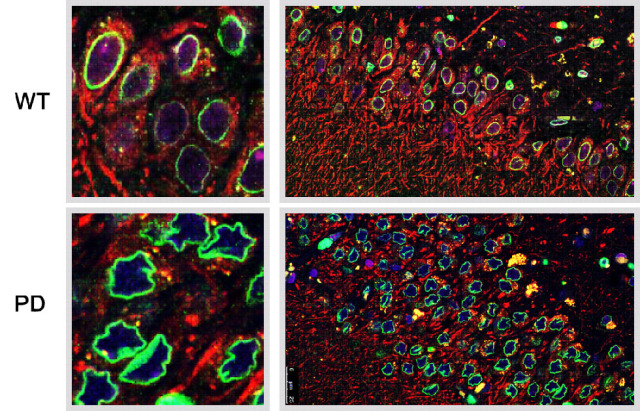Scientists found aberrant nuclear architecture plays roles in Parkinson’s disease
Nucleus may play important roles in the pathology of the Parkinson’s disease(PD) , unraveled by a China-US collaboration project based on the stem cell research and clinical samples investigation, and scientists hope this finding may help to open a new avenues for PD diagnoses and potential therapeutic targets for drug development.
PD is the second most common cause of dementia among the elderly that is characterized by progressive loss of dopaminergic neurons. Till now, PD is estimated to affect over 1.5% global population over 65 years of age, who suffer from bradykinesia, rigidity, resting tremors, dementia and depression,. In China, 2 million people have been diagnosed as PD patients, and the number is expected to keep increasing. To reveal the pathogenic process and the new targets for therapy is of urgent need in both basic research and clinical transformation.
In a paper published in Nature, Professor LIU Guanghui and his group at the Institute of Biophysics, Chinese Academy of Sciences performed the research focusing on how aging affected the neural cell function in PD patients. They reprogrammed the skin cells from PD patients and generated the pluripotent stem cells (iPSCs) carrying a known genetic mutation (LRRK2/G2019S)associated with both familial and sporadic PD cases, and directed the PD iPSC cells differentiated to neural stem cells(NSCs).
They havefound that the gene mutation results in the aberrant nucleus architecture, forming the pedal-like nuclei in neural stem cells (NSCs) during in vitro aging. The deformed NSC nuclear shape is accompanied with decreased abilities of clonal expansion, neural differentiation, and resistance to stresses, which partially explain PD syndrome. Damages to the cells caused by the LRRK2 mutation can be rescued with the targeted gene editing technologies to correct the LRRK mutation or chemical inhibitor of LRRK2, which provides a new hope to develop drugs for PD patients carrying this mutation. Finally, the scientists validated and confirmed nuclear envelope impairments in the brain samples from Parkinson's disease patients.
For the first time, Liu and colleagues reported the cell nuclear architecture defects in PD patients, which can be reversed by gene correction or administration of small molecules. Although more detailed on how the nuclear aberration functions in the PD pathology is not clear yet, these observations still provide a new hope for the PD drug development. Most importantly, these findings proved that the stem cell technology is more than powerful tools in mimicking disease phenotypes, it also provide a platform for ageing related disease pathologies and drug development.
This work was published on Nature (http://www.nature.com/nature/journal/vaop/ncurrent/full/nature11557.html), and supported by the Strategy Priority Research Program of the Chinese Academy of Science, and the National Natural Science Foundation of China.

Figure1. Abnormal nuclear envelope morphology in the neural cells in PD brain.

